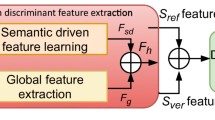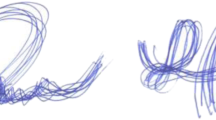Abstract
An efficient offline system for writer independent signature verification is proposed in this work which is quite a difficult task in computer vision. The proposed system employs a novel global representation of signatures followed by the Mahalanobis distance based dissimilarity score to discriminate between the original signatures and their skilled forgeries. The global representation of an image containing signature is based on aggregation of local descriptors using a vocabulary. The global descriptors from the pair of images are then used to learn a low-rank distance metric which is not a trivial task owing to the high dimensionality of the descriptor. The experimental results are reported on two datasets namely CEDAR and BHSig260; both containing a sufficient number of writers and are used as benchmark datasets. A comparison with the state-of-the-art approaches demonstrates the efficiency of our proposed approach. Our proposed method achieved 100% accuracy on CEDAR dataset and outperformed all other methods on BHSig260 (Bengali) dataset. The results on BHSig260 (Hindi) dataset are also promising.




Similar content being viewed by others
REFERENCES
D. Impedovo and G. Pirlo, “Automatic signature verification: The state of the art,” IEEE Trans. Syst. Man Cybern. C (Appl. Rev.) 38 (5), 609–635 (2008).
L. G. Hafemann, R. Sabourin, and L. S. Oliveira, “Offline handwritten signature verification—literature review,” in International Conference on Image Processing Theory, Tools, and Applications (IPTA) (2017), pp. 1–8.
M. K. Kalera, S. Srihari, and A. Xu, “Offline signature verification and identification using distance statistics,” Int. J. Pattern Recognit. Artif. Intell. 18 (7), 1339–1360 (2004).
K. Cpałka, M. Zalasiʼnski, and L. Rutkowski, “New method for the on-line signature verification based on horizontal partitioning,” Pattern Recognit. 47 (8), 2652–2661 (2014).
A. Dutta, U. Pal, and J. Lladós, “Compact correlated features for writer independent signature verification,” in International Conference on Pattern Recognition (ICPR) (2016), pp. 3422–3427.
L. G. Hafemann, R. Sabourin, and L. S. Oliveira, “Learning features for offline handwritten signature verification using deep convolutional neural networks,” Pattern Recognit. 70, 163–176 (2017).
X. Xia, X. Song, F. Luan, J. Zheng, Z. Chen, and X. Ma, “Discriminative feature selection for on-line signature verification,” Pattern Recognit. 74, 422–433 (2018).
A. Bellet, A. Habrard, and M. Sebban, “Metric learning,” Synth. Lect. Artif. Intell. Mach. Learn. 9 (1), 1–151 (2015).
B. Kulis, “Metric learning: A survey,” Found. Trends Machine Learn. 5 (4), 287–364 (2013).
S. Liao, Y. Hu, X. Zhu, and S. Z. Li, “Person re-identification by local maximal occurrence representation and metric learning,” in International Conference on Computer Vision and Pattern Recognition (CVPR) (2015), pp. 2197–2206.
S. Leutenegger, M. Chli, and R. Y. Siegwart, “BRISK: Binary robust invariant scalable keypoints,” in International Conference on Computer Vision (ICCV) (2011), pp. 2548–2555.
N. Dalal and B. Triggs, “Histograms of oriented gradients for human detection,” in International Conference on Computer Vision and Pattern Recognition (CVPR) (2005), Vol. 1, pp. 886–893.
T. Ojala, M. Pietikainen, and T. Maenpaa, “Multiresolution gray-scale and rotation invariant texture classification with local binary patterns,” IEEE Trans. Pattern Anal. Mach. Intell. 24 (7), 971–987 (2002).
H. Jégou, M. Douze, C. Schmid, and P. Pérez, “Aggregating local descriptors into a compact image representation,” in International Conference on Computer Vision and Pattern Recognition (CVPR) (2010), pp. 3304–3311.
R. Arandjelovic and A. Zisserman, “All about VLAD,” in International Conference on Computer Vision and Pattern Recognition (CVPR) (2013), pp. 1578–1585.
S. Pal, A. Alaei, U. Pal, and M. Blumenstein, “Performance of an off-line signature verification method based on texture features on a large indic-script signature dataset,” in IAPR Workshop on Document Analysis Systems (DAS) (2016), pp. 72–77.
M. A. Ferrer, J. Vargas, A. Morales, and A. Ordóñez, “Robustness of offline signature verification based on gray level features,” IEEE Trans. Inf. Forensics Secur. 7 (3), 966–977 (2012).
R. Kumar, J. D. Sharma, and B. Chanda, “Writer-independent off-line signature verification using surroundedness feature,” Pattern Recognit. Lett. 33 (3), 301–308 (2012).
M. B. Yilmaz, B. Yanikoglu, C. Tirkaz, and A. Kholmatov, “Offline signature verification using classifier combination of HOG and LBP features,” in International Joint Conference on Biometrics (IJCB) (2011), pp. 1–7.
D. Rivard, E. Granger, and R. Sabourin, “Multi-feature extraction and selection in writer-independent off-line signature verification,” Int. J. Doc. Anal. Recognit. 16 (1), 83–103 (2013).
H. Rantzsch, H. Yang, and C. Meinel, “Signature embedding: Writer independent offline signature verification with deep metric learning,” in International Symposium on Visual Computing (2016), pp. 616–625.
L. G. Hafemann, R. Sabourin, and L. S. Oliveira, “Analyzing features learned for offline signature verification using Deep CNNs,” in International Conference on Pattern Recognition (ICPR) (2016), pp. 2989–2994.
M. S. Hanif, S. Ahmad, and K. Khurshid, “On the improvement of foreground—background model-based object tracker,” IET Comput. Vision 11 (6), 488–496 (2017).
S. Zafeiriou, C. Zhang, and Z. Zhang, “A survey on face detection in the wild: Past, present and future,” Comput. Vision Image Understanding 138, 1–24 (2015).
F. Perronnin and C. Dance, “Fisher kernels on visual vocabularies for image categorization,” in International Conference on Computer Vision and Pattern Recognition (CVPR) (2007), pp. 1–8.
V. Christlein, D. Bernecker, and E. Angelopoulou, “Writer identification using vlad encoded contour-zernike moments,” in International Conference on Document Analysis and Recognition (ICDAR) (2015), pp. 906–910.
M. Koestinger, M. Hirzer, P. Wohlhart, P. M. Roth, and H. Bischof, “Large scale metric learning from equivalence constraints,” in International Conference on Computer Vision and Pattern Recognition (CVPR) (2012), pp. 2288–2295.
S. Chen and S. Srihari, “A new off-line signature verification method based on graph,” in International Conference on Pattern Recognition (ICPR) (2006), Vol. 2, pp. 869–872.
ACKNOWLEDGMENTS
The authors would like to acknowledge the support of Center of Excellence in Intelligent Engineering Systems (CEIES) and Department of Electrical and Computer Engineering at King Adulaziz University for providing the necessary computational resources for this work.
Author information
Authors and Affiliations
Corresponding authors
Ethics declarations
The authors declare that they have no conflict of interest.
Additional information

Muhammad Shahzad Hanif received his B.Sc. Electrical Engineering in 2001 from University of Engineering and Technology, Lahore, Pakistan, M.S. in Engineering Sciences in 2006 and Ph.D. in Computer Engineering in 2009 from University Pierre and Marie Curie, France. Currently, he is an Associate Professor at the Department of Electrical and Computer, King Abdulaziz University, Jeddah, Saudi Arabia. His research interests include machine learning, image analysis, information fusion, and object detection and tracking.

Muhammad Bilal received B.S. Electronics Engineering from G.I.K Institute of Engineering Sciences and Technology, Pakistan in 2002 and M.S. Computer Engineering and Ph.D. Electrical Engineering from Lahore University of Management Sciences, Pakistan in 2007 and 2013, respectively. He is working as Associate Professor in Department of Electrical and Computer Engineering, King Abdulaziz University, Jeddah, Saudi Arabia since 2014 with joint appointment in Center of Excellence in Intelligent Engineering Systems (CEIES). Earlier he worked at Center for Integrated Smart Sensors (CISS) at KAIST, South Korea as a post-doctoral researcher. His research interests include system design for image and video processing applications, approximate arithmetic circuits, and embedded systems.
Rights and permissions
About this article
Cite this article
Hanif, M.S., Bilal, M. A Metric Learning Approach for Offline Writer Independent Signature Verification. Pattern Recognit. Image Anal. 30, 795–804 (2020). https://doi.org/10.1134/S1054661820040173
Received:
Revised:
Accepted:
Published:
Issue Date:
DOI: https://doi.org/10.1134/S1054661820040173




